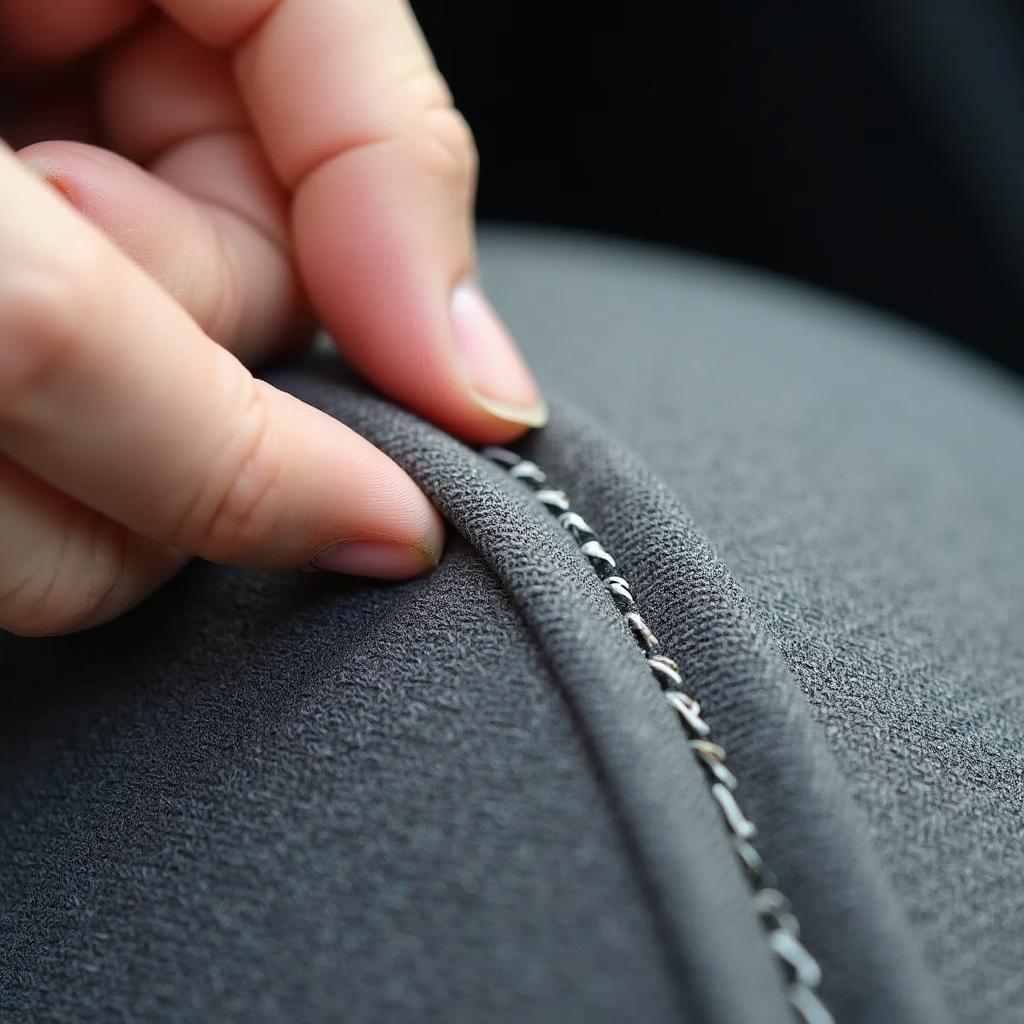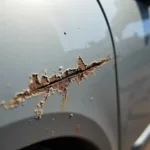A tear in your fabric car seat can be an eyesore and detract from the overall look of your vehicle’s interior. While it might seem like a daunting task, repairing a tear in your car seat upholstery is often a manageable DIY project. This comprehensive guide will walk you through the steps on how to repair a tear in a fabric car seat, helping you save money and restore your car’s interior to its former glory.
Assessing the Damage: When to Repair or Replace?
Before diving into the repair process, it’s essential to assess the severity of the tear. Minor tears and snags can often be fixed with simple techniques, while larger tears with frayed edges or significant damage might necessitate professional intervention or even a seat cover replacement.
Gathering Your Supplies: The Right Tools for the Job
Having the right tools and materials on hand can make the repair process smoother and more efficient. Here’s a list of what you’ll typically need:
- Matching Fabric Patch: Choose a fabric that closely resembles your car seat’s upholstery in color and texture. You can sometimes source a patch from a hidden area of your car, like underneath the seat.
- Scissors: Sharp fabric scissors will ensure clean cuts for your patch.
- Adhesive Backing (Optional): This will help secure the patch to the seat. Choose a fabric-friendly adhesive.
- Upholstery Needle and Thread: Select a thread color that blends seamlessly with your car seat fabric.
- Seam Ripper (If Necessary): This tool helps remove any loose threads or stitching around the tear.
- Iron and Ironing Board: Ironing the fabric patch and the area around the tear can help create a smoother repair.
Repairing the Tear: Step-by-Step Guide
Once you have your tools ready, follow these steps to repair the tear:
- Clean the Area: Begin by thoroughly cleaning the area around the tear with a suitable fabric cleaner or a mild soap and water solution. Allow the area to dry completely before proceeding.
- Prepare the Patch (If Using): If you’re using a fabric patch, cut it to a size slightly larger than the tear, ensuring it covers the edges comfortably. If using adhesive backing, apply it to the back of the patch according to the manufacturer’s instructions.
- Position the Patch: Carefully align the patch over the tear, ensuring it lies flat and covers the damaged area completely.
- Secure the Patch: If you’re using an adhesive patch, press it firmly onto the tear, following the adhesive’s recommended drying time. If sewing, use a simple straight stitch or a whipstitch to secure the patch to the car seat fabric. Keep your stitches small and even for a discreet finish.
- Finishing Touches: Once the patch is secured, use a seam ripper to carefully remove any loose threads. Avoid pulling on the threads, as this could worsen the tear.
Alternative Repair Methods: Beyond Sewing
For smaller tears or snags, you can consider these alternative repair methods:
- Fabric Glue: Fabric glue can be a quick and easy solution for minor tears. Choose a fabric glue specifically designed for upholstery and apply it sparingly to the edges of the tear. Press the edges together firmly and allow ample drying time.
- Liquid Seam Sealant: Similar to fabric glue, a liquid seam sealant can effectively bond the edges of the tear together. Apply the sealant according to the product instructions, ensuring it penetrates the fabric.
Preventing Future Tears: Proactive Measures
While repairing a tear is achievable, preventing future damage is always a good approach. Here are some preventive measures to keep your car seats in top condition:
- Regular Cleaning: Regularly cleaning your car’s interior, including the seats, can help prevent dirt and debris from causing abrasions and tears.
- Seat Covers: Using seat covers can provide an extra layer of protection, especially if you frequently transport pets, children, or cargo.
- Careful Entry and Exit: Be mindful of sharp objects, such as keys or tools, that can accidentally tear your car seats.
When to Seek Professional Help: Knowing Your Limits
While DIY repairs can be effective for many fabric car seat tears, there are instances when seeking professional help is advisable. If the tear is extensive, involves complex stitching patterns, or affects the seat’s structural integrity, it’s best to consult a professional upholstery repair shop. They have the expertise and specialized tools to handle more intricate repairs.
Conclusion: Restoring Your Car’s Interior
Repairing a tear in your fabric car seat can be a rewarding DIY project that saves you money and maintains your vehicle’s interior aesthetics. By following these steps and choosing the appropriate repair method for the tear’s severity, you can restore your car seats to their former glory and enjoy a more comfortable and visually appealing driving experience.
FAQs: Frequently Asked Questions about Fabric Car Seat Repairs
Q: Can I use super glue to fix a tear in my car seat?
A: While tempting, it’s not recommended to use super glue on fabric car seats. Super glue can create a stiff and inflexible bond that might crack or peel over time, especially with the seat’s constant movement and pressure.
Q: What’s the best way to prevent my car seats from fading?
A: Prolonged exposure to sunlight is a primary cause of car seat fading. Consider using a sunshade on your windshield when parking your car outdoors and park in shaded areas whenever possible.
Q: How often should I clean my car seats?
A: It’s generally recommended to clean your car seats every 1-2 months, or more frequently if you frequently transport children, pets, or engage in outdoor activities.
For more information on car upholstery repairs, check out these helpful resources:
- How to Repair a Rip in Leather Car Seat
- How to Repair Car Seat Seam
- How Much to Repair Torn Seats on a Car
- How to Repair a Leather Car Seat Hole
- How to Repair a Tear in Fabric Car Seat
Need assistance with your car seat repair? Our team of expert technicians is just a message away. Contact us via WhatsApp at +1(641)206-8880 or email us at [email protected]. We offer 24/7 customer support to answer your questions and guide you through the repair process.



